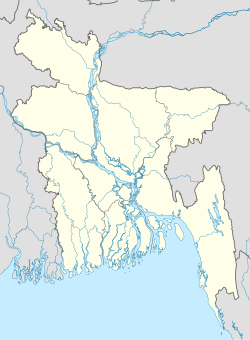Ullahpara Upazila
|
ullapara উল্লাপাড়া |
|
|---|---|
| Upazila | |
| Location in Bangladesh | |
| Coordinates: 24°19.2′N 89°34′E / 24.3200°N 89.567°ECoordinates: 24°19.2′N 89°34′E / 24.3200°N 89.567°E | |
| Country | Bangladesh |
| Division | Rajshahi Division |
| District | Sirajganj District |
| Area | |
| • Total | 414.43 km2 (160.01 sq mi) |
| Population (1991) | |
| • Total | 399,074 |
| • Density | 960/km2 (2,500/sq mi) |
| Time zone | BST (UTC+6) |
| Postal code | [6760] |
| Website | Map |
Ullahpara (Bengali: উল্লাপাড়া) is an upazila in Sirajganj District, Rajshahi Division, Bangladesh. It is known as the gateway to North Bengal, since the Dhaka-Rangpur and Dhaka-Rajshahi highways intersect at Hatikumrul in Ullahpara.
Around 4500 BC, the region of Varendra consisted of parts of Dinajpur, Joypurhat, Bogra, Rajshahi and western Pabna. Pabna and Mymensingh were formed by the deposition of alluvial river soil. At that time, there was no Jamuna River, and Sirajganj and Tangail were part of Mymensingh. According to the Chinese traveler Xuanzang, Sirajgonj was inhabited for seven centuries before the Jamuna began to separate the region from the rest of Mymensingh. At that time, the new region was underwater for eight or nine months of the year. According to Xuanzang, the west bank of the Karatoya River was in the kingdom of Pundravardhana; Ullapara was probably also in th kingdom at the time. The area was settled during the eras of Muslim administration (1204-1757) and the British Raj (1757-1947) before a business center was established. In 1875 a thana (police station) was built, and on July 2, 1983 Ullahpara became an upazila.
Ullahpara, with 69,479 households and an area of 414 square kilometres (160 sq mi), was built on alluvial soil deposited by the Padma, Jamuna and other rivers. The upazilas of Raiganj and Tarash are to the north, Tarash and Bhangura to the west, Faridpur and Shahjadpur to the south and Belkuchi and Kamarkhanda to the east. Ullahpara is an estimated 10–12 feet (3.0–3.7 m) above sea level, and is drained by the Karatoya, Fulzor, Jopjopia and Kamla Dargadoh Rivers. The average annual high temperature is 35 °C (95 °F), and the average low is 21 °C (70 °F). Annual average rainfall is 170–190 centimetres (67–75 in).
...
Wikipedia

